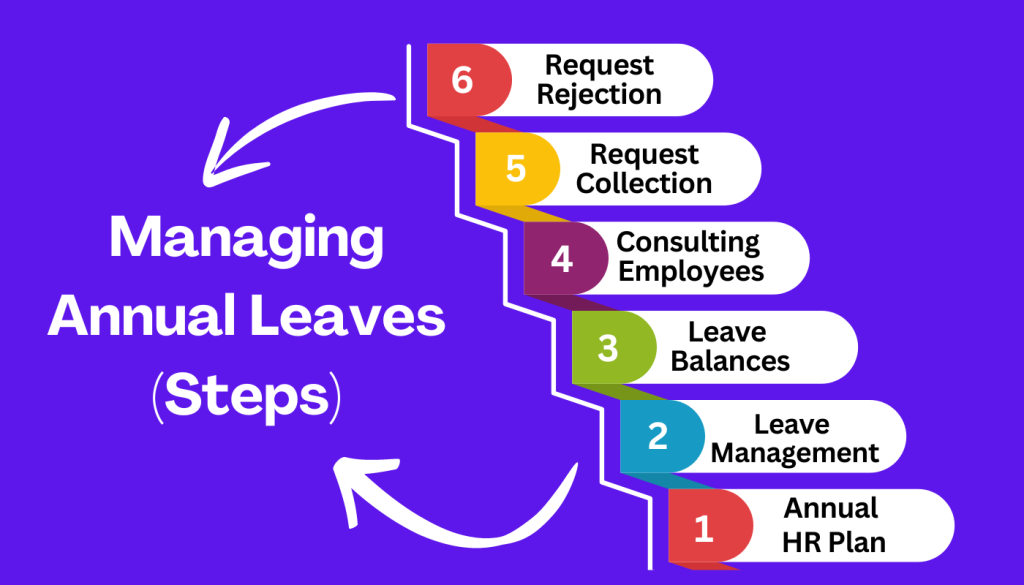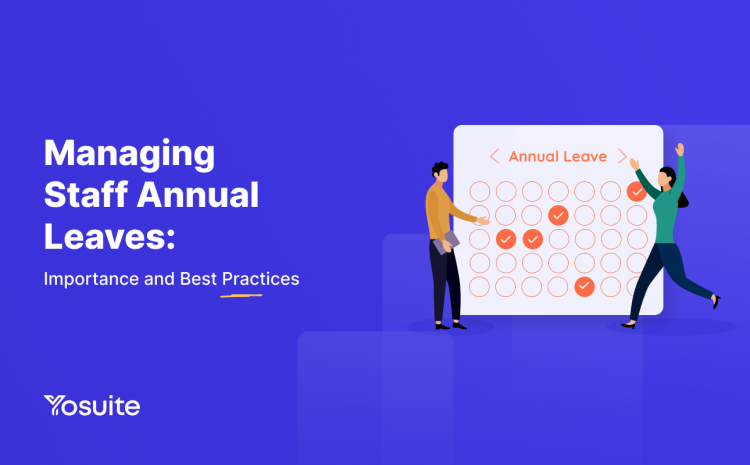Availing leaves to employees is a crucial decision of HR teams that can make or break an employee’s morale. Especially, when it comes to managing annual leaves of staff, one has to be very careful about the process and entitlements.
In this blog post, we will discuss in detail about annual leave management and the best practices that will set you apart from other organizations. Let’s dive in.
What is annual leave management?
In layman’s terms, annual leave is the amount of paid time off the company offers an employee for personal reasons other than sick leave, government holidays, or paternity/maternity leave. It is part of the annual compensation and benefits package of a salaried employee.
The purpose of annual leave is typically to give time off to employees for personal emergencies, to relax with family, or simply to rejuvenate and come back to the office recharged. However, depending on the country, city, or territory, leave for illness may also be part of it.
For instance, in Australia and New Zealand, the annual leave is also called holiday pay. In India, this leave type is called Earned Leave because you ‘earn’ these leaves for days worked.
Importance and Impact of Annual Leave Management
Annual leaves are something employees want from the management as a privilege for the year-round hard work and efforts they put in. Ensuring employees enjoy annual leave accordingly boosts employee morale and uplifts their perception of the organization they work for.
For instance, in a country like Brazil, you can take 30 days of annual leave after a year of service. In Australia and New Zealand, both full-time and part-time workers can avail of 4 weeks of annual leave for every 12 months worked.
On the flip side, in the US, the FLSA does not require payment for time not worked, for annual leave. An employer may, at his/her will, allow paid annual leaves to the employee as per contract.
In the UK, the law requires at least 28 days of paid annual leave to full-time workers, which includes public holidays, too.
These stats show the importance employers across different regions emphasize entitling annual leaves to their employees.
Failing to manage annual leave can make you:
- Overlap vacations among key team members, causing uncontrolled role conflicts during critical periods.
- Spur missed deadlines that decrease overall productivity
- Create unfair distribution of leave approvals leading to feelings of resentment and inequity among employees
- Compromise operations as employees scramble to cover for absent colleagues, potentially leading to burnout and stress
- Inadequately keeping records and communicating poorly, resulting in misunderstandings about available leave days and conflicting time-off requests.
- erode employee engagement,
- hinder the organization’s ability to meet its goals effectively and efficiently.
How do you manage annual leave? (Steps)

Managing and ensuring requires thorough planning and strategizing. You also need to understand each employee’s current work situation and needs. Let’s look at the major steps in managing annual leaves.
1. Setting the Annual HR Plan
The first step for the HR personnel is to ensure they have the annual HR plan set up and aligned with organizational goals. The annual HR plan is the strategic direction that includes all the matters related to the people’s side of an organization, from recruitment and compensation to performance and training for a 12-month period; preferably the upcoming 12 months. The HR plan outlines everything an organization is doing to manage the people’s side of their business.
Thus, the leave quotas for each employee and/or team/department are determined in the HR plan. It has an indirect impact on the HR budget as well, which allocates finances to particular HR functions and operations.
2. Creating a Leave Management System
The second thing the HR department does is ensure a leave management system, which is usually part of the attendance management of an organization. This is crucial for managing annual leaves because this system determines how well the HR team tracks and manages leaves.
Companies worldwide are now shifting toward automated leave management through leave management or Paid Time Off (PTO) software. However, many organizations in lesser-developed countries opt for manually tracking attendance via registers or time tracking sheets.
3. Tracking Employees Leave Balances
Once the leave management system is set up, the authorized HR persons should check the leave balances and accrued leaves of the employees. This is a tricky step because when you check the leave records, multiple types of leaves are taken by the employees. In some cases, leaves tend to overlap.
For instance, an employee might have already taken three days of casual leave to go on vacation. So, it can raise some eyebrows if the entitled annual leaves are used as paid time off for vacation. This is where the HR team has to be very careful in setting up and communicating the policies.
You should have the leave applications from previous days in your record. If you are using a software solution, then it should have the leave applications entered in it. If you are using a manual register, then the leaves should be recorded there. For example, if an employee is eligible for a maximum of 12 annual leaves per year and it is calculated as one leave for every month, then the leave balance should be recorded as per how many leaves he availed and how many he can avail of.
4. Consulting Employees Regarding Leave Plan
After calculating the leave balances, the HR team now has to discuss with each employee their entitled, availed, and pending annual leaves. Especially, if it’s the end of the year, the HR manager or executive must convey to the concerned employee whether or not they want to use the remaining leave for paid time off or carry it forward to next year.
For instance, in India, state laws allow a minimum of 30 days to a maximum of 60 days of leave to be carried forward to the next year. However, in the UK, there is no fixed law in allowing carryover of accrued annual leaves, though if employers want they may allow up to 4 weeks of annual leave to be carried over.
5. Collecting Annual Leave Requests
Now that you have sorted out the leave balances and talked with the employees, you can collect leave applications for annual leave. Depending on your local laws and company policies, you may allow entitled employees multiple annual leave days in a row.
Also, depending on your leave management system, the application can be done digitally through software solutions or on paper.
However, you should be aware of how much impact an employee’s absence will have on the other team members and team goals. You should also allow leave to those who are eligible for it, simply to improve the workplace environment and boost productivity. There should be a strategic plan for allowing annual leaves to balance employee morale boost and smooth continuation of operations.
6. Rejecting Annual Leave Requests
Managing annual leaves of staff is the most difficult when you have to reject some applications. In the US, where PTO is not mandatory, you can reject it easily without much explanation. However, in countries like the UK, Canada, or Australia, where minimum annual leaves are mandated, not allowing leave requests can be legally harmful.
You would need a solid reason or a clause in the appointment or employment contract letter stating the entitlement of leave is subject to workload or particular conditions.
The Difficulties in Managing Annual Leave
Like any other process, managing annual leaves also has its share of difficulties and challenges when implementing.
🔴Multiple Annual Leave Requests
One issue that HR personnel face is multiple annual leave requests. If more than a few employees across departments request leave, then it becomes difficult to allocate the leave. If you allow leave to one person, then the other may feel deprived. However, you cannot allow too many employees to enjoy the leaves simultaneously. Someone has to do the
🔴Mixed Leaves Request
Another complication occurs when employees want to take mixed leaves. This means the employee takes, say, 5 days of parental leave and 5 days of PTO in his/her 10 days of leave. In such cases, the HR personnel face difficulties in tracking down and allocating leaves to particular categories like sick leave, casual leave, annual leave, and so on.
🔴Cultural Diversity Issues
The terms DEI or DEIB are becoming quite prevalent nowadays. With multiple cross-national and cross-cultural teams working in organizations, HR managers now need to consider what might be offensive to a particular group, and what might a particular employee or group from a minority culture want to stay engaged in.
For instance, if a Muslim employee wants PTO during the Eid holidays, he/she should be given that as it’s his/her religious holiday. That is if you are operating in a Non-Muslim country with Eid not being a government holiday. However, what about if an employee wants to celebrate or observe a national day of his/her homeland, deeply rooted in his/her beliefs and lifestyle?
Should you allow them an annual leave then? Whatever step the HR manager takes, it cannot harm the employee’s sentiments or core beliefs.
🔴Untimely record-keeping of annual leaves
One of the biggest challenges to any leave management is record-keeping. Regardless of the number of employees, if leave applications are not submitted timely or there are changes to the taking of leaves, keeping track of leaves and holidays can be a grueling task.
Either way, the whole leave tracking process has to be repeated again – and quickly too! This hampers proper salary processing as well.

Ways to Improve Annual Leave Management
Though there are complications and difficulties in managing annual leaves, there are some best practices that you can implement to improve the process.
🟢Incorporating Advanced Annual leave trackers
One of the best solutions you can ensure to any leave management process is by integrating advanced, automated annual leave systems. These solutions can help you by expediting the leave tracking process, automating leave records, minimizing errors, and improving productivity.
Usually, if you set up an automated Attendance Management system with annual leave tracking integration, it would do you a world of good. You can access real-time reports, manage records remotely, and track annual leave applications online and instantly.
🟢Discussing About Leaves with Employees
A best practice to ensure you and the employees are happy is to talk to them about annual leaves. As an HR personnel, convey to them about what type of leaves they can avail and in what amounts. Inform them periodically about their yearly leave status. Transparency is key.
🟢Understanding Individual Leave Needs
As already discussed, respecting diversity, equity, and inclusion is crucial to an organization’s reputation and eventual survival in the industry. You should discuss with your organizational team members when they would like to avail of annual leaves and why. Sometimes, the best performers are from minority groups, so ensuring they stay happy is paramount to your overall organizational success.
🟢Ensuring Fair Policies
The code of conduct and employee handbook should be drafted so that it clearly states the leave processes of the employees. However, the policies need to be fair for all employees, taking into account each group of employees’ needs and rights. The documents should be shared with the employees from the very start of their tenure with the organization and reminded the employees every month.
Wrapping up
Managing annual leaves is not an easy task; neither is it a hard one, if done appropriately and with the right tools. As an HR professional, you should always try to ensure a work-life balance for your employees and colleagues so that they feel extrinsically motivated and perform to their best potential.
You should also ensure that no employee is misusing or misunderstanding the annual leave policies of the organization. For that, you should foster transparency, implement fair policies, and make sure to convey the consequences of not abiding by the rules.
FAQ
Types of Leaves
Besides annual leaves, there are various leaves that an organization offers to its employees. Some of the more common leaves include:
- Sick Leave due to illness or injury.
- Bereavement Leave to grieve the loss of a loved one.
- Compensatory Off is given in exchange for working overtime hours.
- Maternity/Paternity Leave for childbirth or adoption
You can learn more about different types of leaves and how to manage them.



Leave a Reply